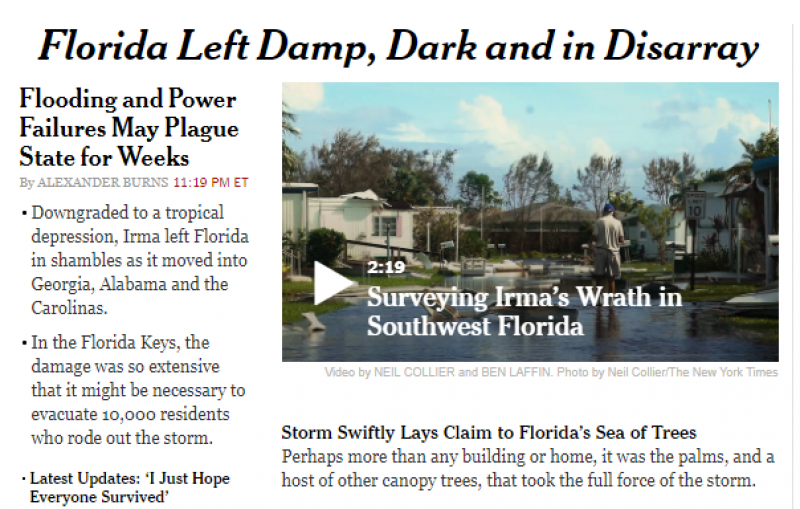 Florida emerged from Hurricane Irma on Monday as a landscape of blacked-out cities, shuttered gas stations, shattered trees and flooded streets, while the now-weakened storm kept sweeping northward.
Florida emerged from Hurricane Irma on Monday as a landscape of blacked-out cities, shuttered gas stations, shattered trees and flooded streets, while the now-weakened storm kept sweeping northward.
Major streets remained underwater in cities from Miami to Jacksonville, with even more roads snarled by debris. As many as nine million Floridians lost electricity at some point during the storm, and the chief executive of a major utility, Florida Power & Light, said that it could take weeks to restore full service.
Officials were still assessing Irma’s impact in the Florida Keys, which may have borne the worst of the storm. After a survey of the islands, Gov. Rick Scott told reporters that he had seen the crippling damage there, including countless overturned trailers and many boats washed ashore. Recovery in the Keys would be a “long road,” he said.
“I just hope everybody survived,” Mr. Scott said. “It’s horrible, what we saw.”
Later on Monday, the Defense Department said that damage to the Keys was so extensive that it might be necessary to evacuate the 10,000 residents who rode out the storm on the islands.
Three other states — Georgia, South Carolina, and Alabama — issued storm and tornado warnings as they prepared for their own brush with Irma, which was downgraded to a tropical depression late Monday as its winds slowed. The Georgia Emergency Management Agency alerted residents to “historic levels of flooding” on the Atlantic Coast and urged people to take shelter if they had not already evacuated. By Monday afternoon, about a million people in Georgia and South Carolina had lost power.
On Isle of Palms, S.C., a small barrier island and beach destination near Charleston, Irma caused serious flooding on Monday and threatened more extensive damage with the next high tide overnight. Mayor Dick Cronin said most people on the island did not evacuate because they saw the storm moving westward. He estimated that half the island’s roads were at least partially submerged, and some were impassable.
Insurance experts began offering projections on Monday for the total cost of the storm’s damage, with initial estimates running in the range of $20 billion to $50 billion.
Jacksonville found itself caught between three water threats, city officials said: High tides, the storm surge driven by Irma’s winds and the torrential rains over the weekend that have swollen rivers and streams.
While much of Central Florida was spared the worst of Irma’s fury, a low-slung pocket of Orange County, which includes Orlando, woke up to furious flooding. Before dawn, National Guard troops and Orange County Fire Rescue crews worked to rescue nearly 150 people and an unknown number of family pets, in some cases from water that had reached three to six feet.
Urgent calls for help began coming just before 2 a.m. Monday as streets in the area turned to streams. Robert Jenkins and his family were rescued around 9 a.m.
On Marco Island, near Naples, where the eye of the storm came ashore on Sunday afternoon, Captain Dave Baer of the island’s police department said that rescuers had pivoted on Monday to what he called “well-being checks,” as people who were off the island during the storm inquired about friends and relatives who had not been heard from or who needed assistance.
Jake Love, a resident of East Naples on Florida’s west coast, returned to his mobile home on Monday to find about a foot of water in his driveway and a piece of his siding bent upward, but no more ruinous damage than that. Mr. Love said he had moved to Florida just a month ago from Minnesota with his parents and had taken shelter on Saturday night at Temple Shalom in Naples.
Power losses appeared to be the state’s most widespread affliction. In news conferences up and down the state, mayors and utility executives delivered the dispiriting statistics: In densely populated Pinellas County west of Tampa, about 70 percent of Duke Energy’s customers, or 395,000 people, were without electricity, with no immediate restoration in sight. Mayor Tomás Regalado of Miami said a similar fraction of his city was dark, with roads left impassable and traffic lights not working. In Orlando, about half the city’s utility customers had no service.
At the White House, Thomas P. Bossert, the president’s Homeland Security adviser, said repairing the electrical system would require “the largest-ever mobilization of line restoration workers in this country, period.”
Medical facilities and nursing homes reported struggles with power supplies. Though utility companies make restoring service to hospitals a priority, some were still lacking normal service on Monday. As of Monday night, 36 Florida hospitals were closed, and 54 were operating on backup generators, according to data from the Florida Department of Health.
Millions of people in less mortal danger still faced the bleak prospect of doing without air conditioning and electric appliances for days or even weeks to come. Some families took refuge in their cars to escape the heat and humidity, but their vehicular respite may prove fleeting: Many gas stations across South Florida were closed for want of power, fuel or both, leaving some motorists driving for miles in a futile search for gasoline.
Still, areas that had braced for a lethal catastrophe felt lucky to get away with just prolonged discomfort and a mess to clean up.
 Leads Of The World
Leads Of The World
30926 hour(s) 16 minute(s) ago ;
Morning 09:10 ; Saturday ; Apr 27, 2024
The New York TimesFlorida Starts Coping with Irma’s Aftermath
Send
International Desk
Published : 14:04, Sep 12, 2017 | Updated : 14:06, Sep 12, 2017
Published : 14:04, Sep 12, 2017 | Updated : 14:06, Sep 12, 2017
0 ...0 ...
Topics: Exclusive
- KOICA donates medical supplies to BSMMU
- 5 more flights to take back British nationals to London
- Covid19: Rajarbagh, Mohammadpur worst affected
- Momen joins UN solidarity song over COVID-19 combat
- Covid-19: OIC to hold special meeting
- WFP begins food distribution in Cox’s Bazar
- WFP begins food distribution in Cox’s Bazar
- 290 return home to Australia
- Third charter flight for US citizens to return home
- Dhaka proposes to postpone D8 Summit
Unauthorized use of news, image, information, etc published by Bangla Tribune is punishable by copyright law. Appropriate legal steps will be taken by the management against any person or body that infringes those laws.
Bangla Tribune is one of the most revered online newspapers in Bangladesh, due to its reputation of neutral coverage and incisive analysis.
F R Tower, 8/C Panthapath, Shukrabad, Dhaka-1207 | Phone: 58151324; 58151326, Fax: 58151329 | Mob: 01730794527, 01730794528


